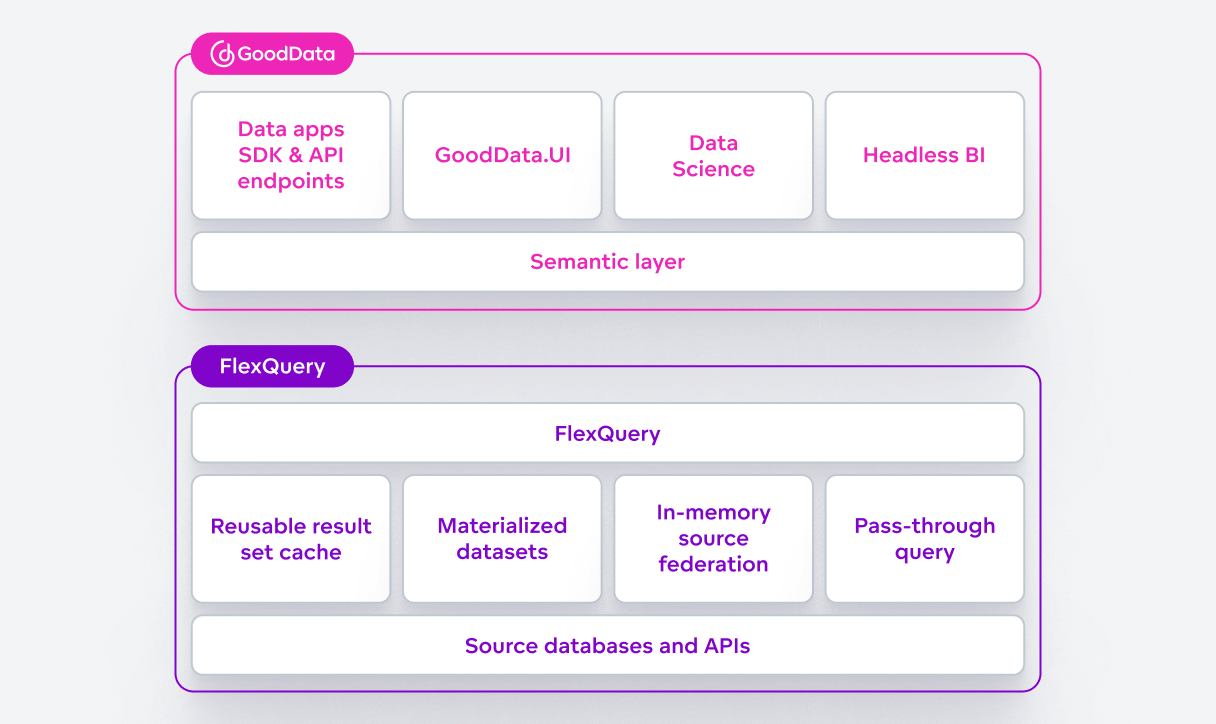Our Vision for the Next Generation of BI and Analytics


The last twelve months have seen a convergence of technologies, most notably generative AI, that is poised to disrupt the long-stagnant enterprise BI market. Here at GoodData, we’ve been busy thinking, learning, and building, and today we’re ready to announce our vision for the next generation of business intelligence and analytics.
While most vendors are focused exclusively on the end-user experience, we’re leaning into our industry-leading ‘analytics-as-code’ roots to deliver the premier platform for data builders looking for speed, scale, and productivity — enhanced by generative AI.
Introducing the Analytics Lake
What does that mean? Over the next year, we’re delivering an end-to-end data platform that combines storage, compute, semantics, and reporting in an open, API-first analytics-as-code architecture with built-in AI acceleration. Our vision gives analytics and data engineers a set of APIs that define, optimize, visualize, and distribute data to any downstream experience or use case. This is enabled via standard software engineering practices like CI/CD and code-based automation, rather than a series of clunky, proprietary UI-only experiences like with the traditional BI stack. Combined with our no-code/low-code environments for analysts and consumers, we provide a single point of collaboration for every data persona.
We call this vision — of an analytics-focused platform offering all of this — the ‘Analytics Lake’. Unlike a data lake, the Analytics Lake’s storage and compute are optimized for analytics and ML metadata and other analytics artifacts and not long-term storage. We integrate metadata modeling and a headless semantic layer into the lake architecture itself and offer a powerful BI and visualization environment on top. All of this tooling provided by a single vendor, under a single umbrella of declarative APIs and generative AI tools gives analytics builders unprecedented scale, agility, and data quality — especially when compared to the monolithic, proprietary UI-bound BI and analytics approaches of the 2010s.

Benefits of the Analytics Lake
The Analytics Lake brings many benefits to data builders and consumers:
- Performance: Moving analytics-ready data to the same platform as the metrics layer and data products dramatically increases performance.
- Cost Efficiency: Less data processing on your cloud DW and less data movement means lower TCO for data solutions.
- Openness: Embracing open-source technologies and analytics-as-code makes us a great citizen in your data ecosystem.
- Governance: Building a comprehensive, metrics-driven data platform ensures data quality for all downstream uses - BI, AI, and custom applications.
Powered by FlexQuery
The first phase of this vision launches today. Called FlexQuery and built on the cutting edge in-memory Apache Arrow open source project, FlexQuery provides a super-high performance, intelligent analytics cache (FlexCache) with infinite scale built on the advanced in-memory Intel AVX-512 architecture. Using FlexQuery, engineers cut query times and save money by reducing expensive cloud data warehouse query processing. As the computational heart of our headless BI engine, FlexQuery delivers superior performance to all downstream data users — BI consumers in GoodData’s UI, data scientists using our Python SDKs, or application developers using our react.js libraries. Now, all personas have access to a consistent set of high-quality, governed metrics with superior in-memory performance, regardless of where they sit.
FlexQuery is much more than a cache though. We will be rolling out our Analytics Lake vision over the next year across four major releases:
- Release 1: Query acceleration and result set caching (live now!)
- Release 2: Last-mile ETL and data engineering
- Release 3: Data source federation
- Release 4: AI-driven intelligent pre-caching
All of this is built, deployed, managed, and automated using our declarative APIs and SDKs, or our low-code/no-code UI. FlexQuery turbocharges our commitment to openness — open standards and common libraries, deployed on any cloud.
FlexQuery is available in the GoodData cloud today and all cloud customers are using it as we speak.
An AI-Accelerated Vision
As you can see above, we’re quite serious about this API-first, engineering approach to analytics driven by code. Code is, of course, a form of language. And our code allows you to make fine-grained or platform-wide, bulk changes to your metadata models, metrics, and dashboards.
With that in mind, we’re currently testing internal LLMs that help developers generate, test, and deploy this code. Think of it as an AI assistant who understands GoodData at an expert level and radically accelerates the process of scaling your analytics. Combined with the FlexQuery Analytics Lake, this assistant helps you build pipelines, in-memory caches, or semantic models. It intelligently pre-caches data based on semantic awareness and usage statistics. And of course, it suggests the next best visualization or explains in natural language the outliers in a data set. But it also designs the entire dashboard for you, using code.
That is, in essence, our vision. A single platform, optimized for analytics with blazing fast compute, moving metrics and insights into whatever user experience gives them the maximum impact. And all of it is supported by generative AI built for the builders, to help data and analytics engineers achieve unheard-of speed, agility, and scale in the data industry.
It’s why we’re so excited for GoodData’s future, and why we invite you to join us by starting a trial today.
Why not try our 30-day free trial?
Fully managed, AI-accelerated analytics platform. Get instant access — no installation or credit card required.
Try it now

